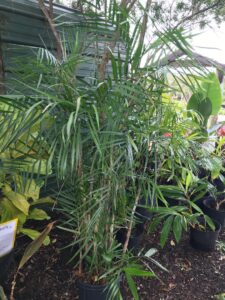S & J Tree Farm and Nurserys Guide to Growing
Bamboo Reed Palms
in the Northeast Florida, Jacksonville /
St. Augustine area Landscape
( Chamaeadorea seifrizii )

Bamboo Reed Palm / Chamaedorea seifrizii Origins:
-Chamaedorea is a large genus of palms from Central and South America that include some of the most commonly cultivated species in the world. Bamboo palms Parlor palms and Cat palms are among them. Chamaedorea seifrizii / Bamboo Reed palm is native to north America – Mexico, Central and South America and grows in both moist soils that are frequently wet and arid areas. It is considered one of the most drought tolerant of the Chamaedorea species and makes an excellent indoor palm that is pet safe in our Zone 9a Northeast Florida, Jacksonville and St. Augustine area home gardens.
– Plant these palms as understory plants under larger native Oaks and
Maples or on the south side of the house and where fences, etc. protect them from harsh north winter winds in Zones 9b-11.
Plant can suffer frond damage in harsh frosts at 35-36 degrees and are thought to be root hardy to 28 degrees.
Prefferred Exposure of Bamboo Reed Palm / Chamaedorea seifrizii:
– Full shade or filtered shade under taller tree canopies is ideal for Bamboo reed palms when planted outdoors and bright indirect light is best for indoor palms although the Bamboo reed Palm is tolerant of extreme low light conditions. Plants getting too much sunlight will have yellowed out fronds.
Bamboo Reed Palm / Chamaedorea seifrizii Fronds | Trunk:
– Widely cultivated member of the Chamaedorea genus cultivated for its highly decorative foliage, beautiful upright half inch trunks with conspicuous ring scars in clusters resembling a bamboo plant but with a much more decorative top. Each stem holds 6-9 leaves. The fronds of Chamaedorea seifrizii are gently arching and can sometimes vary widely in the individual leaf size but all have a fernlike or feathery appearance. Pinnately compound with 2-3 dozen leaflets on the stem. Bright Medium Green coloring green fernlike fronds have a gentle arching form and are densely suckering at the base in a generous clump. Very Similar in appearance to the Chamaedorea microspadix and chamaedorea elegans. Really very pretty plants.
– Foliage will remain evergreen but can damage with a hard frost and should be protected if planted outdoors with any frost or freeze. Plant may suffer frond damage on an annual basis and is root hardy to 28 degrees. Planting in shadier locations out of the reach of light frosts helps protect the palm from winter damage as well as placing it on the south side of a home or fence or another tree etc.
Soil Preference / Salt tolerance of the Bamboo Reed Palm:
– Bamboo Reed palms grow in both very moist / wet soils and higher more arid areas in their native locations. they are considered one of the most drought tolerant of the water loving chamaedorea genus of palms. The wide tolerance of natural habitat makes them easier to place in the landscape and more forgiving of underwatering than most. Not seemingly particular about soil components.
– Low salt tolerance, avoid coastal area plantings.
Size Variance / Growth Rate of the Bamboo Reed Palm / Chameadorea seifrizii :
– Bamboo Reed Palm are very slow growing
and only reach sizes of 6-12 feet High and 5-6 ft wide. Normally seen at the 7 ft height range in South Florida.
– These members of the Chameadorea family are extremely slow growing and reach that mature height very slowly. Expect 5-7 years or more to get them to their mature size in our Northeast Florida Jacksonville and St. Augustine area gardens.
Growth Habit of the Bamboo Reed palm:
– Bamboo Reed Palms have highly decorative foliage and a clumping habit with fronds on slender upright half inch trunks giving them the common bamboo name. Fronds tend to weep downwards with a gently arching habit.
Bamboo Reed Palm Bloom:
– Yellowed flower clusters are inconspicuous near the base of the palm fronds and are typical of the Chameadorea genus and followed by round green berry like fruits that age to a deep black.
Water Requirements of Bamboo Reed Palm :
– This palm should be difficult to overwater as it grows in moist soils that are occasionally inundated in its native range. That being said it also grows in drier higher elevated areas of its native range and for a chamaodorea palm, is quite drought tolerant. I have found my indoor potted bamboo reed palm quite forgiving of my neglect!
Best Uses For bamboo Reed Palm in the Northeast Florida | Jacksonville | St. Augustine area landscape:
– Bamboo Reed Palms are an excellent choice for container plants for indoor use. Their forgiving nature and upright growth habit make them useful in a wide variety of settings and tight spaces.
These palms may be more tolerant than the information I have been able to gather on them suggest. most nurseries list them as zone 10-11 outdoors. My outdoor trial is doing well and passed its second winter with NO LEAF DAMAGE. That being said, it is in a protected spot next to a shed and under a large live Oak tree so no frost gets to it but so far the foliage has not damaged with 29 degree temperatures so go figure. Perhaps this will be a viable outdoor option, or maybe its just one year from being a dead palm. We shall see….. 🙂
- Excellent potted plant for patio and pool areas or bright indirect light indoors.
– Soft root systems allow palms to be planted near house foundations,
patios, walkways and other hardscape with no damage to the tree or the paved areas.
Care of the Bamboo Reed Palm:
– Bamboo Reed Palm will need good water during the establishment period and supplemental irrigation when planted into well drained locations in the landscape.
– Bamboo Reed Palm respond well to supplemental irrigation and fertilizer treatments.
– In our Northeast Florida landscape, you can fertilize each fall with magnesium sulfate and a palm food mix to ensure your palm goes into the winter season as healthy as possible when planted outdoors.
– Minimal pruning is required to keep these palms looking their best, trim off old browned out palm fronds each year in early spring or as needed.
Remember not to trim off fronds that are yellowing until they have completely browned.
MINIMUM PALM FERTILIZER REGIMEN – what you should be doing to keep your palm healthy
– Fertilize only as needed when palms show signs of nutrient deficiencies with a specially targeted nutrient that it needs, follow manufacturers directions and apply 1/2 lb o 1lb of fertilizer per inch of diameter of trunk on your palm, measured from a hands width above the ground level. That means for a 12 inch wide trunk from left to right you would need 6-12 lbs of fertilizer for just that one palm! To know what your palm needs get familiar with the nutritional deficiencies and their symptoms of your palm or take a frond to your local county agricultural extension office for them to analyze.
St. Johns County Agriculture Extenison Office:
Address: 3125 Agricultural Center Dr, St. Augustine, FL 32092 (904) 209-0655
Clay County Agricultural Extension Office:
2463 FL-16, Green Cove Springs, FL 32043 Phone: (904) 284-6355
Flagler County Agricultural Extension Office
150 Sawgrass Rd, Bunnell, FL 32110 Phone: (386) 437-7464
Duval County Agricultural Extension office:
Located in:Duval County Family WellbeingAddress: 1010 N McDuff Ave, Jacksonville, FL 32254 Phone: (904) 255-7450
Nassau County
543350 US-1, Callahan, FL 32011 Phone: (904) 530-6353
Putnam County
111 Yelvington Rd # 1, East Palatka, FL 32131 Phone: (386) 329-0318
– Fertilize cold sensitive palms each fall with magnesium sulfate to keep your palm green and healthy through the winter months!
MAXIMUM PALM FERTILIZER REGIMEN – what you can do to get your palm up and growing Fast!
– Palms and other plants grow in direct relation to the amount of water and nutrient available to them. In Florida’s sandy soils nutrient deficiencies can occur after a few years of growing in the same space. When signs of deficiency occur Fertilize every three months with an application of the missing nutrient. Your local department of agriculture extension service will be able to provide you with the needed nutrients to purchase and apply. In most cases, this is all that is needed to keep your palm healthy and thriving, the occasional correction of nutrient deficiencies. In the 14 years of growing Queen/ Pindo / Mule / Sylvestris and Pygmy Date palms in the sand in front of my house, two palms ( both queens) have needed nutrient correction twice. Once requiring only one application of palm food and once requiring three applications before correcting the issue.
If attempting to get your palm growing at its maximum rates as would be done in a nursery setting, fertilize every three months with a well balanced palm food mix and apply supplemental irrigation twice weekly.
TIP – Wait till fronds have turned completely brown before removing from the palm as the palm will take back in the nutrients from those older leaves and use it when forming new ones.
*CAUTION – DO NOT FERTILIZE NEWLY PLANTED
/ TRANSPLANTED FIELD GROWN PALM TREES WITH PALM
FOOD! Palm food instructions are for ESTABLISHED palms not palms with confined root systems that are as little as of what they would be had they been grown from seed in the ground. Let your palm develop new roots for a year in the ground before applying any fertilizer.
Note : When planting smaller palms being grown in a container, this rule does not apply, rather, use one third to one half the recommended application rate for your trunks diameter, as container palms roots have not been damaged or cut during planting but are still only a portion as large as they would be if the palm had been growing in the ground and excess fertilizer on a confined root system is still not preferable for maximum health.
Palm fertilizers are water soluble and will burn the new roots your palm tree is trying to put out as it establishes itself into the landscape. It is best to use only poly coated plant food that is heat release like Osmocote general purpose fertilizer or non burning Milorganite in the first year in the landscape, and then the following year, start your palm food regimen that will provide all of the minor nutrients that your palms will need to keep them healthy and problem free in Florida’s soils.

